The Banana Problem: A new report from Fuels Institute tackles the complex defossilization of medium to heavy duty transport
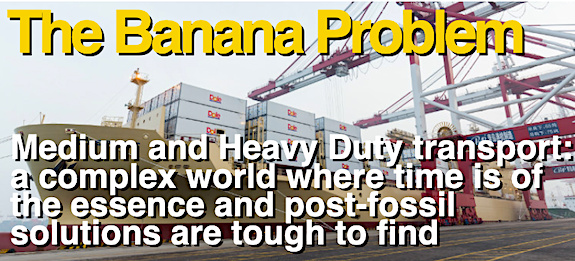
In the world of freight, how you look at the time-energy-emissions equation kinds depends on what you’re hauling. It’s the banana problem. Taking 20+ days to sail from Jamaica to Florida is a great example of low-energy, low-emission travel, but it doesn’t work for bananas unless you have refrigeration on board, which defeats the point. In freight, there are a much broader array of types of transit, models of usage. IIt’;s a world of high specificity, high customization.
As this site shows, https://www.lowtechmagazine.com/2009/12/trolley-canal-boats.html hands down the cheapest mechanical way to haul anything from point A to B is via a water canal where the traction is supplied not via propeller but by a connection to land, such as a dragging cable. The fact that we don’t see much of it tells you that heavy-duty applications are not driven by emissions, or by energy considerations alone. It’s nothing like the monolithic world of sedan cars used for commuting and personal transport. Heavy-duty is emergency, freight, refuse, public transit, construction, towing, mobility for primary industry and more.
The complexity of freight and the fearsome cost competitiveness of commodity transport has led many authorities to leave defossilizing of medium to heavy duty transport, known in the acronym business as MHDV, for another time — rather than kick the can down the road, they kicked the truck.
Just this week, the Fuels Institute stepped forward with a refreshing blast of data and clarity in their report “The Easiest and Hardest Commercial Vehicles to Decarbonize”, (download here) and the incisive analyst Tammy Klein commented:
“I thought the nuanced discussion in this paper was good. There really is no one-size-fits-all solution that captures the kaleidoscope that is the medium and heavy duty vehicle market. I can see lots of #electrification, lots of renewable fuels including renewable natural gas, renewable diesel and biodiesel, and hydrogen as that market scales up. The issue is going to be whether the policy will be one-size-must-fit-all. I’m thinking here of the ACT in California, which other states are preparing to follow.”
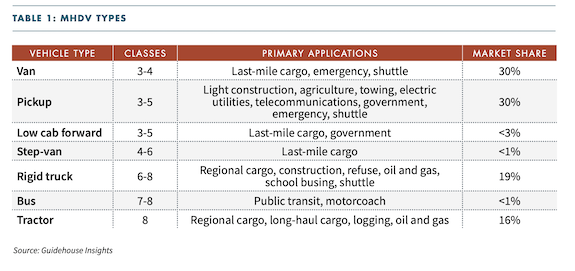
The Fuels Institute noted in the report:
“MHDVs emit nearly 1/3 of U.S. on-road greenhouse gas emissions, but strategies that work for light duty vehicles may not apply to these vehicles. This is why the Fuels Institute today is releasing our latest report focusing on this critical sector of the economy.
This new report, written by Guidehouse Insights, dissects the complexities of the MHDV market, identifying 17 unique vehicle types within the sector and evaluating their use applications, duty cycles, energy needs and share of GHG emissions. They then evaluated what opportunities and challenges exist for each vehicle application when it comes to decarbonizing.
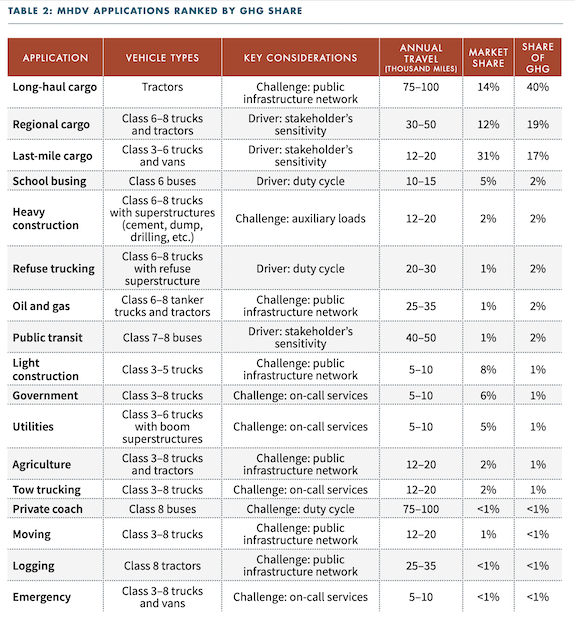
The paper (which you can download here highlights that the top five MHDV applications affect nearly 50% of the market and are responsible for 42% of emissions. Meanwhile the bottom five affect 20% of the market but are responsible for 45% of emissions.
The 5 easiest
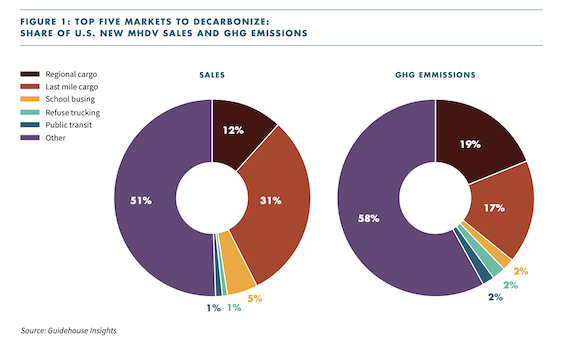
The report identifies 5 of the easiest MHDV applications for decarbonization. They identified five attributes: Stakeholder sensitivity, Ownership periods, Return-to-base routes Urban operations and Low energy-density requirements.
The top applications were Regional Cargo, Last-Mile Cargo, Refuse Trucking Public Transit And School Busing. #1 was School Busing
The Bottom Five?
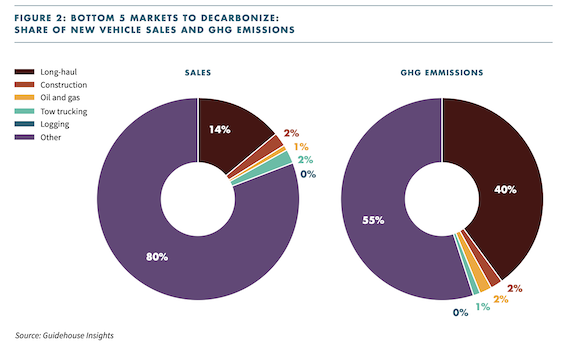
The issues were:Stakeholder sensitivity, Ownership periods, Publicly accessible refueling needs, Rural operations, and Non-motive auxiliary loads:
The apps were: Tow Trucking, Logging Trucks, 3: Heavy Construction, Oil And Gas Trucking, and Long-Haul Cargo
The needed policies
The report recommended
• Policy targets aligned to the viability of decarbonization by MHDV application, the feasible timelines for infrastructure development thereof, recognition of costs thereof, and financial mechanisms or commitments to reduce uncertainty regarding policy viability.
• Increased financial support mechanisms to spur renewable energy resource development and decrease carbon intensity of all transportation
fuel pathways.
• Holistic accounting of emissions by considering vehicles and fuels as an integrated system rather than independent components to ensure fair competition between decarbonization solutions.
• Funding for pilot studies and demonstrations needed to gain real-world
data, experience, and stakeholder confidence.
The Bottom Line
The Institute observed that MHDVs account for nearly 30% of US road-transport emissions and 7% of overall GHG emissions, and for that reasons there’s pressure on industry to take a lead in defossilize.
The report cautions that “massive investments need to be made across the supply chain to develop renewable resources, distribution infrastructure, and the enabling vehicle technologies. These investments need the support of governments and major corporations keen to see GHG emissions reduced”. It is not yet clear that many in Big industry or Big Government are yet focused on the problem. It’s clear that national Net Zero targets are nigh impossible to reach without progress in this sector. The key is probably not to wait for massive government investment but to get the ball rolling in some “easy to defossilize” sectors. Converting school busing over to renewable diesel seems like the easiest step of all in terms of using a drop-in fuel with no infrastructure conversion required — what is needed is a national initiative to make low carbon pricing available to all school buses, not just those in California, Oregon and Washington. Book and claim might be just the right way to look at it — book the fuel when it goes into a school bus and claim the credit in states that offer it. It’s something that LCFS regulators will have to begin to address how much they care if the reduction in carbon has to take place within their state borders — at the end of the day, the skies don’t care much where the debossilizatino happens.
The carbon regimes all too often get hung up on that.
Category: Top Stories















